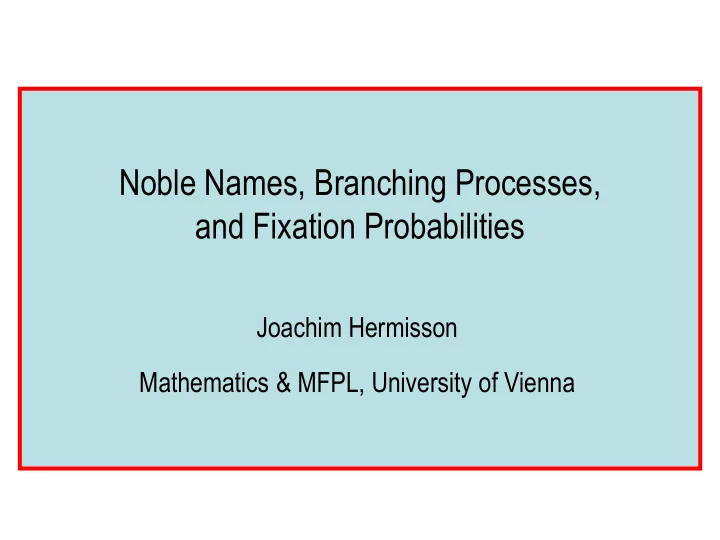

Noble names, branching processes, and fixation probabilities Noble Names, Branching Processes, and Fixation Probabilities Joachim Hermisson Mathematics & MFPL, University of Vienna
Noble names, branching processes, and fixation probabilities The fate of aristocratic family names A problem of inheritance inspires new mathematics “The decay of the families of men who occupied conspicuous positions in the past times has been a subject of frequent remark and has given rise to various conjectures …“ [Galton and Watson 1874] Sir Francis Galton (1822-1911) Conjecture: • Aristocrats (or “other men of genius“) have reduced fertility → trade-off ? • Population only maintained by proletarians Degradation risk ! Galton: Henry William Watson • It may also be just chance: Need a model ! (1827 - 1903)
Noble names, branching processes, and fixation probabilities Galton‘s branching model • Z 0 founders of noble families in generation n = 0 • Each founder j can have k j = 0,1,2,3, … sons → independently and with identical probability p k Sir Francis Galton k 1 = ? (1822-1911) k 2 = ? k 3 = ? Henry William Watson Z 0 → Z 1 (1827 - 1903)
Noble names, branching processes, and fixation probabilities Galton‘s branching model • Z 0 founders of noble families in generation n = 0 • Each founder j can have k j = 0,1,2,3, … sons → independently and with identical probability p k • Iterate with offspring generation Sir Francis Galton (1822-1911) Henry William Watson Z 0 → Z 1 → Z 2 → … Z n (1827 - 1903)
Noble names, branching processes, and fixation probabilities Galton‘s branching model with offspring A Galton-Watson process Z n 0 n distribution is a Markov chain with values p k 0 k in and transition probabilities Sir Francis Galton m | P Z k Z m p 1 i i k (1822-1911) where is the m-fold convolution of p m p k k (i.e., the distribution of the sum of m i.i.d. random variables, each with distribution ) p k Due to independence, we can use Z 0 = 1 as default initial state (“fate of one family“) Henry William Watson (1827 - 1903)
Noble names, branching processes, and fixation probabilities Watson‘s insights probability for extinction by generation n : n use generating function of offspring distribution k ( ) t p k t Sir Francis Galton 0 k (1822-1911) Recursion: 1 n n n (monotonic and bounded) Thus: fixed point of ( t ) ( continuous) Henry William Watson (1827 - 1903)
Noble names, branching processes, and fixation probabilities k ( ) Fixed points of t p k t ( t ) 0 k ( 1 ) 1 1 k ' ( 1 ) k p k average offspring number) Case : 1 Assume: • p 0 > 0 ( ) 0 t • p 0 + p 1 < 1 ( 0 ) ( ) 0 p t 0 t 1
Noble names, branching processes, and fixation probabilities k ( ) Fixed points of t p k t ( t ) 0 k ( 1 ) 1 1 k ' ( 1 ) k p k average offspring number) Case : 1 Assume: • p 0 > 0 ( ) 0 t • p 0 + p 1 < 1 ( ) 0 t t 1
Noble names, branching processes, and fixation probabilities k ( ) Fixed points of t p k t ( t ) 0 k ( 1 ) 1 1 k ' ( 1 ) k p k average offspring number) Case : 1 Assume: p 0 0 • p 0 > 0 ( ) 0 t • p 0 + p 1 < 1 ( ) 0 t t 1
Noble names, branching processes, and fixation probabilities Extinction probability Thus: smallest fixed point of ( t ) For average offspring number: k p k k subcritical 1 . 1 1 critical 2 . 1 1 supercritical 3 . 1 • Galton and Watson overlooked the smaller fixed point and concluded that all family names must die out because of chance alone • Lotka (1931): for US white males (1920 data) 0 . 82
Noble names, branching processes, and fixation probabilities Fixation probability The spread of a rare beneficial mutant through a population can be described as a supercritical branching process [Fisher 1922, Haldane 1927] Ronald A. Fisher J. B. S. Haldane The fate of a beneficial mutant is decided while it is rare • When frequent: loss very unlikely → eventual fixation (frequency 1) • While rare: independent reproduction! Mutant population can be described by a branching process Fixation probability follow as: 1 p fix
Noble names, branching processes, and fixation probabilities Fixation probability Average offspring number Wildtype: (constant population size) 1 wt (typical s : 10 -4 – 10 -2 → “ slightly supercitical“ ) 1 Mutant: s m Taylor expansion of the fixed point equation: 2 1 1 1 ( 1 ) ( 1 ) ( 1 ) p p p p fix fix fix fix 2 where: ( 1 ) 1 ( 1 ) ; m 2 ( 1 ) ( 1 ) ( 1 ) k k p k m m m 2 k 2 ( variance of the offspring distribution) : m
Noble names, branching processes, and fixation probabilities Fixation probability Solve for : p fix 2 1 2 s 2 m p s fix 2 2 1 m m m m In particular, Wright-Fisher model (~ Poisson offspring distribution): 2 2 (Haldane 1927) p fix hs 1 hs m m (all mutants in heterozygotes) almost all beneficial mutations in a Typical s : 10 -4 – 10 -2 population are lost because of random fluctuations (genetic drift)
Recommend
More recommend